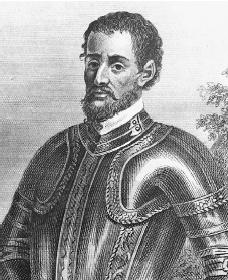Hernando de Soto Biography
Born: c. 1496
Jerez de los Caballeros, Spain
Died: May 21, 1542
Ferriday (now in Louisiana in the United States)
Spanish explorer
The Spanish explorer Hernando de Soto participated in the conquests of Nicaragua (in Middle America) and Peru (in South America). De Soto explored parts of nine states in the southeastern part of the United States, and he was the first white man to cross the Mississippi River.
Born to explore
Hernando de Soto was born sometime between 1496 and 1501 at Jerez de los Caballeros in the province of Estremadura, Spain. He was born into a family with minor nobility and little money as the second son of Francisco Mendez de Soto and Leonor Arias Tinoco. His education was limited; he was more interested in adventure and exploration. With little more than a sword and shield he sailed to Central America in 1514 with Pedro Arias de Ávila (c. 1440–1531), known as Pedrarias, who was about to become the governor of Panama.
As Pedrarias's lieutenant, de Soto was allowed to explore Central America in search of treasure and land. Among the areas he explored in the 1520s were modern Costa Rica and Honduras. De Soto conquered Nicaragua in 1524, and along with Hernan Ponce de Leon and Francisco Companon, he became a leading citizen of that country. De Soto was ambitious and wanted the chance to rule a country, but Pedrarias blocked his attempts to achieve more power in Nicaragua.
Fame and reward
Sailing from Nicaragua in 1531, de Soto joined Francisco Pizarro (1471–1541) in the conquest of Peru, becoming an important figure in the fight. He was the first Spaniard to meet the Inca leader Atahualpa (c. 1500–1533), who had led the victory of a recent civil war in Peru. Atahualpa had great wealth, and he gave many gifts to de Soto. Pizarro later had Atahualpa killed while de Soto was on a scouting mission. Although de Soto emerged from the conquest with a reputation as a skilled horseman and "one of the four bravest captains who had gone to the West Indies," he was upset that Pizarro had killed Atahualpa. He also felt he would never be given the opportunity to provide leadership to a country.
With fame and a fortune of 100 thousand pesos in gold, de Soto returned to Spain in 1536, where he married Isabella de Bobadilla, one of Pedrarias's daughters. De Soto was very interested in starting up a new expedition. He got his chance when Emperor Charles V of Spain (1500–1558) rewarded him for his efforts in Peru with a title as governor of Cuba and the authority to explore, conquer, and set up colonies (at his own expense) in the entire region that is now the southern part of the United States. De Soto returned to Cuba in 1538, where he assumed the governorship and prepared for his expedition to Florida.
An explorer until the end
Hoping to find another Peru, de Soto and 620 men landed south of modern Tampa Bay, Florida, on May 30, 1539. His party encountered a man named Juan Ortiz, a survivor of an earlier failed expedition to Florida, who had lived among the Indians for twelve years. With Ortiz acting as interpreter, de Soto began his search for treasure and an advanced Indian civilization. Marching up the west coast of Florida, he spent the winter near the

Courtesy of the
De Soto and his followers, anxious to find riches, set out once again to the north-west into northern Mississippi. In May 1541 de Soto sighted the Mississippi River south of current-day Memphis, Tennessee. After crossing the Mississippi he explored Arkansas, and established his winter quarters near the present site of Fort Smith. Having made up his mind to return to the sea, he reached the mouth of the Arkansas River, where he died of fever on May 21, 1542. De Soto's men wrapped his body in cloaks packed with sand and cast it into the river. The 311 survivors of the expedition, under Luis de Moscoso, floated down the Mississippi and coasted along the Gulf shore until they reached Tampico, Mexico, in September 1543.
For More Information
Clayton, Lawrence A., Vernon James Knight Jr., and Edward C. Moore, eds. The De Soto Chronicles. Tuscaloosa: University of Alabama Press, 1993.
Duncan, David Ewing. Hernando de Soto: A Savage Quest in the Americas. New York: Crown Publishers, 1995.
Whitman, Sylvia. Hernando De Soto and the Explorers of the American South. New York: Chelsea House, 1991.